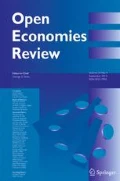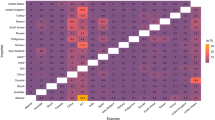Abstract
This paper investigates the welfare consequences of international policy cooperation by simultaneously introducing the following three elements in a standard two-country general equilibrium model: (i) general degrees of exchange rate pass-through, (ii) nontradable goods and their sector-specific productivity shocks, and (iii) general weights on goods in Cobb–Douglas consumption indices. There are two channels for possible mutual welfare gains from policy cooperation: First, cooperation can compensate for insufficient changes in the terms of trade when the degree of exchange rate pass-through is intermediate. Second, countries can cooperate in reaction to shocks in the nontradable goods sectors. This second channel is revealed by deriving an analytical condition for welfare gains under full pass-through and this condition is characterized by the weights in the consumption indices and the variances of sector-specific productivity shocks. Numerical evaluation demonstrates that when the two countries are symmetric and equal weights on consumption goods are assumed, welfare gains from cooperation increase as symmetric pass-through elasticity increases, which implies that the second channel dominates the first, whose effect on welfare gains is nonmonotonic in pass-through elasticity.




Similar content being viewed by others
Notes
Throughout the paper, intermediate pass-through is defined as pass-through elasticity that is strictly positive and less than one.
In a more general formulation (e.g. Benigno and Benigno (2003), Duarte and Stockman (2005), and Corsetti et al. (2008)), the tradable good consumption index is given by a CES (constant elasticity of substitution) function. Letting the elasticity of substitution between Home and Foreign traded goods equal to one gives Eq. 3.
The derivation follows Corsetti and Pesenti (2004). Note that γ = 1 − γ ∗ and ϕ = ϕ ∗ are assumed in their derivation. As pointed out by Corsetti and Pesenti (2005), the balanced equilibrium current account relies on the following three assumptions: (i) the Cobb–Douglas consumption indices, (ii) the logarithmic utility function of consumption, and (iii) zero initial non-monetary wealth.
If a complete market is assumed, as in Devereux and Engel (2003) and Devereux et al. (2007), the marginal utility from nominal spending is equalized across countries, up to a weighting constant. One can see that risk sharing is attained in the model with a weighting constant \(\frac {(1-\gamma )\phi }{(1-\gamma ^{*})\phi ^{*}}\), although the model does not assume a complete market. Note that this constant is equal to unity if the two countries’ consumption indices are symmetric, that is, if γ = γ ∗ and ϕ = ϕ ∗.
For the Home country, \(\int _{0}^{1}(M_{t}(j)-M_{t-1}(j))dj + \int _{0}^{1}\mathcal {T}_{t}(j)dj = 0\). The Foreign counterpart is analogous.
See the Appendix for the closed-form expressions of the welfare functions.
Recall that the Home (Foreign) country’s welfare is W ( W ∗) plus additional terms. Since the additional terms do not depend on policy rules, they cancel each other out and do not appear in the equation for welfare gains.
Note that the intuition for the Foreign country is similar.
Suppose, for now, that technology shocks are countrywide in both countries and that the shocks in the tradable and nontradable goods sectors are identical, as in Obstfeld and Rogoff (2002). In this situation, monetary policy responses under cooperation coincide with those under noncooperation, since \(\xi _{1}^C+\xi _{2}^{C} = \xi _{1}^{N} + \xi _{2}^{N}\), \(\xi _{3}^C+\xi _{4}^{C} = \xi _{3}^{N} + \xi _{4}^{N}\), and the same relations for ψ.
Another extreme case with no gains from cooperation is when ϕ = ϕ ∗ = 0. In this case, the two countries are completely separate economies and there are obviously no gains from cooperation.
This condition is imposed in the numerical experiment in Section 4.2.
The results are not sensitive to the value of symmetric variances. Setting \(\sigma _{u_{\mathrm {N}}}^{2} = \sigma _{u_{\mathrm {N}}^{*}}^{2} = 1\) and \(\sigma _{u_{\mathrm {N}}}^{2} = \sigma _{u_{\mathrm {N}}^{*}}^{2} = 0.1\) leads to similar results.
References
Benigno G, Benigno P (2003) Price stability in open economies. Rev Econ Stud 70:743–764
Canzoneri MB, Cumby RE, Diba BT (2005) The need for international policy coordination: what’s old, what’s new, what’s yet to come? J Int Econ 66:363–384
Cole HL, Obstfeld M (1991) Commodity trade and international risk sharing: how much do financial markets matter? J Monet Econ 28:3–24
Corsetti G, Dedola L, Leduc S (2008) International risk sharing and the transmission of productivity shocks. Rev Econ Stud 75:443–473
Corsetti G, Pesenti P (2001) Welfare and macroeconomic interdependence. Q J Econ 116:421–445
Corsetti G, Pesenti P (2002) Self-validating optimum currency areas. Mimeo
Corsetti G, Pesenti P (2004) International dimensions of optimal monetary policy. Mimeo
Corsetti G, Pesenti P (2005) International dimensions of optimal monetary policy. J Monet Econ 52:281–305
Corsetti G, Pesenti P (2007) The simple geometry of transmission and stabilization in closed and open economies. In: Clarida RH, Giavazzi F (eds) NBER international seminar on macroeconomics 2007, pp 65–116
Devereux MB, Engel C (2003) Monetary policy in the open economy revisited: price setting and exchange-rate flexibility. Rev Econ Stud 70:765–783
Devereux MB, Engel C, Tille C (2003) Exchange rate pass-through and the welfare effects of the euro. Int Econ Rev 44:223–242
Devereux MB, Shi K, Xu J (2007) Global monetary policy under a dollar standard. J Int Econ 71:113–132
Duarte M, Obstfeld M (2008) Monetary policy in the open economy revisited: the case for exchange-rate flexibility restored. J Int Money Financ 27:949–957
Duarte M, Stockman AC (2005) Rational speculation and exchange rates. J Monet Econ 52:3–29
Goldberg L, Tille C (2008) Vehicle currency use in international trade. J Int Econ 76:177–192
Goldberg L, Tille C (2009) Macroeconomic interdependence and the international role of the dollar. J Monet Econ 56:990–1003
Goldberg L, Tille C (2011) Micro, macro, and strategic forces in international trade invoicing. Mimeo
Obstfeld M, Rogoff K (2000) New directions for stochastic open economy models. J Int Econ 50:117–153
Obstfeld M, Rogoff K (2002) Global implications of self-oriented national monetary rules. Q J Econ 117:503–535
Author information
Authors and Affiliations
Corresponding author
Additional information
For helpful comments, I thank George Tavlas (Editor), an anonymous referee, Nan-Kuang Chen, Biing-Shen Kuo, Wei-Wei Lee, Yiting Li, Guillaume Rocheteau, Hung-Jen Wang and seminar participants at National Taiwan University, National Chengchi University, National Chung Cheng University, the ASSA (CEANA-NTU-TEA Session) in San Diego, and the Singapore Economic Review Conference. Financial support from the National Science Council is gratefully acknowledged.
Appendix
Appendix
This appendix describes the welfare functions for both countries. As in the text, W and W ∗ denote the Home and Foreign welfare functions, respectively. Due to the properties of the model, these welfare functions can be described in closed form, following an approach taken by Devereux and Engel (2003). For the sake of brevity, I provide only the welfare functions below.
The Home welfare function is given by
where lowercase letters denote the log of the corresponding variables (i.e. c ≡ lnC and \(e \equiv \ln \mathcal {E}\)) and σ x y denotes the covariance between x and y. The second moments are given by
Similarly, the Foreign welfare function is given by
where the second moments are given by
Rights and permissions
About this article
Cite this article
Kashiwagi, M. Implications of Exchange Rate Pass-Through and Nontradable Goods for International Policy Cooperation. Open Econ Rev 25, 771–795 (2014). https://doi.org/10.1007/s11079-013-9306-4
Published:
Issue Date:
DOI: https://doi.org/10.1007/s11079-013-9306-4
Keywords
- Monetary policy
- International cooperation
- Nominal rigidities
- Exchange rate pass-through
- Nontradable goods




